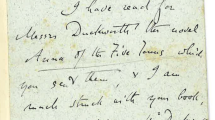Abstract
The title of this chapter names two incommensurate bodies: nineteenth-century fiction and the canon. The first is unwieldy, almost monstrous, in its proportions; an estimated 60,000 novels were published between 1855 and 1890 alone (Maunder, 2005, p. 20). Such figures, moreover, do not take into account the explosion of serialized fiction within the growing number of popular periodicals launched during the same period. Within such publications, as Margaret Oliphant suggests, “There are stories to begin with, stories to end with, and stories in the middle” (1858, p. 204). Such was the growth in the production of popular fiction that a critic writing for Tait’s Edinburgh Magazine could declare, without irony, that the “‘age of iron,’ the ‘age of steam,’ and all the various epithets by which that period of time in which we live is distinguished at every progressive step, seem about to retire before the newer one of the ‘age of cheap literature’” (Anon., 1852, p. 118). Resisting, for the moment, the urge to qualify and question, we may simply state that the canon is, in contrast, a much more select and circumscribed body consisting of a mere handful of works. Out of the thousands of published nineteenth-century authors, Francis O’Gorman’s recent – fairly standard – list of the “acknowledged great names of Victorian fiction” includes only nine: Charlotte and Emily Brontë, Charles Dickens, George Eliot, Elizabeth Gaskell, Thomas Hardy, Henry James, William Makepeace Thackeray, and Anthony Trollope (2002, p. 2).
Every week beholds a new irruption of emigrants into the sunny land of fiction, sadly disturbing the old balance of power, and introducing a fearful confusion of names and habits. Within a few years, all the proprieties of the domain have been violated by the intrusion of hordes of ruffians, pickpockets, and vagabonds. Sir Charles Grandison finds himself face to face with Jack Sheppard, and no scorn sparkling in the eyes of Di Vernon can abash the impudence of Mr. Richard Turpin. The swagger of vulgar villainy, the lisp of genteel imbecility, and the free and easy manner of Wap**, are now quite the rage in the Elysian fields of romance.
(Whipple, 1848, p. 354)
Access this chapter
Tax calculation will be finalised at checkout
Purchases are for personal use only
Preview
Unable to display preview. Download preview PDF.
Similar content being viewed by others
Works cited
Anon, “Literature,” Tait’s Edinburgh Magazine, 19 (February 1852), pp. 118–29.
Arnold, Matthew (1869), Culture and Anarchy. Ed. J. Dover Wilson (Cambridge: Cambridge University Press, 1971).
Beller, Anne-Marie, “Teaching Victorian Popular Fiction and the Problems of Literary Value,” paper delivered at Victorian Literature: The Canon and Beyond Conference (University of Chester, 2006).
Brake, Laurel, “Writing, cultural production, and the periodical press,” in J. B. Bullen (ed.) Writing and Victorianism (London and New York: Longman Press, 1997), pp. 54–72.
Burroughs, Catherine, “Teaching Women Playwrights from the British Romantic Period (1790–1840),” in J. Moskal and S. R. Wooden (eds.) Teaching British Women Writers1750–1900 (New York: Peter Lang, 2005), pp. 140–59.
Easthope, Anthony (2003) “But What is Cultural Studies,” in S. Bassnett (ed.) Studying British Cultures: An Introduction (London and New York: Routledge, 2003), pp. 3–19.
Gilbert, Pamela. K., Disease, Desire and the Body in Victorian Women’s Popular Novels (Cambridge: Cambridge University Press, 1997).
Gilbert, Pamela. K., Map** the Victorian Social Body (New York: State University of New York Press, 2004).
Guillory, John, Cultural Capital: The Problem of Literary Canon Formation (Chicago and London: The University of Chicago Press, 1993).
Hernstein Smith, Barbara, Contingencies of Value: Alternative Perspectives for Critical Theory (Cambridge, MA: Harvard University Press, 1988).
Hughes, Winifred, “The Sensation Novel,” in P. Brantlinger and W. B. Thesing (eds.) A Companion to the Victorian Novel (Malden, MA and Oxford: Blackwell Publishing, 2005), pp. 260–78.
Lootens, Tricia, Lost Saints: Silence, Gender, and Victorian Literary Canonization (Charlottesville, VA: University of Virginia Press, 1996).
Maunder, Andrew, “Map** the Victorian Sensation Novel: Some Recent and Future Trends,” Literature Compass (2005), pp. 1–32.
Nemesvari, Richard, “‘Judged by a Purely Literary Standard’: Sensation Fiction, Horizons of Expectation, and the Generic Construction of Victorian Realism,” in K. Harrison and R. Fantina (eds.) Victorian Sensations: Essays on a Scandalous Genre (Columbus: The Ohio State University Press, 2006), pp. 15–28.
O’Beebee, Thomas, The Ideology of Genre: A Comparative Study of Generic Instability (University Park, PA: The Pennsylvania State University Press, 1994).
O’Gorman, Francis, The Victorian Novel (Oxford: Blackwell Publishing, 2002).
Oliphant, Margaret, “The Byways of Literature – Reading for the Million,” Blackwood’s Edinburgh Magazine, 84 (1858), pp. 200–16.
Oliphant, Margaret. “Novels,” Blackwood’s Edinburgh Magazine, 102 (1867), pp. 257–80.
Simmons Jr., James. R, “Pedagogy and Oppositions: Teaching Non-Canonical British Women Writers at the Technical University,” in J. Moskal and S. R. Wooden (eds.) Teaching British Women Writers1750–1900 (New York: Peter Lang, 2005), pp. 91–100.
Whipple, Edwin. P, “Novels of the Season,” The North American Review, 67 (1848), pp. 354–69.
Widdowson, Peter, Literature (London and New York: Routledge, 1999).
Editor information
Editors and Affiliations
Copyright information
© 2010 Janice M. Allan
About this chapter
Cite this chapter
Allan, J.M. (2010). The Canon: Map** Writers and Their Works. In: Maunder, A., Phegley, J. (eds) Teaching Nineteenth-Century Fiction. Teaching the New English. Palgrave Macmillan, London. https://doi.org/10.1057/9780230281264_2
Download citation
DOI: https://doi.org/10.1057/9780230281264_2
Publisher Name: Palgrave Macmillan, London
Print ISBN: 978-0-230-53781-1
Online ISBN: 978-0-230-28126-4
eBook Packages: Palgrave Literature CollectionLiterature, Cultural and Media Studies (R0)




